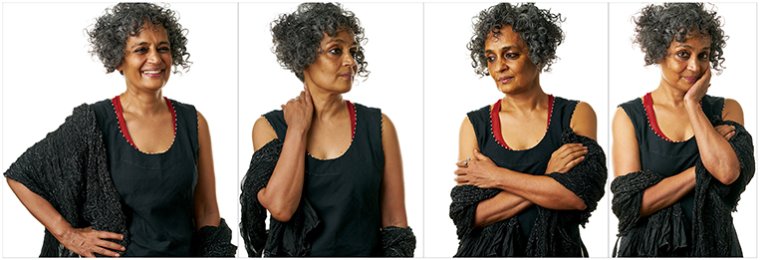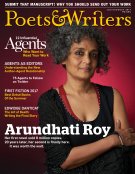The novel is teeming with indelible characters: politicians—some murderously demented—accountants, teachers, militants, and mothers in a multigenerational story. There’s the irrepressible Ustad Kulsoom Bi, guru and head of the Hijra household that Anjem joins initially; the incorrigible Saddam Hussain, a name he chose for himself; the two Miss Jebeens, one killed by a bullet that passed through her skull into her mother’s heart, the other abandoned on a Delhi street and claimed by Anjum; the shape-shifting Amrik Singh, “a cheery cold-blooded killer.” A central quartet of characters—Musa, Naga, Garson Hobart (a code name for Biplab Dasgupta), and Tilo, the one the other three love—meet as students, go their separate ways, then weave in and out of one another’s lives in a plot that moves between the poverty-stricken neighborhoods of Old Delhi, the glittering new wealth of malls and hotels, and the mountains and valleys of Kashmir.

Although it’s tempting to see some of these characters as representations of different viewpoints in Indian politics, Roy objects: “Even Dasgupta is partly the voice of the establishment and partly a lost, lovelorn wreck. Hazrat Sarmad, Hazrat of the Indeterminate, is the deity of this book.” Thus, Roy’s characters are, first and foremost, complicated human beings who remind us that “we do a great injustice to people when we ‘unsee’ their identities and the discrimination they suffer because of that identity,” she says. “Equally, we do great injustice when we see nothing of a person except to brand them with one single identity. Sometimes people do this even to themselves.”
The dazzling array of characters, while hardly autobiographical, does suggest Roy’s own wide spectrum of experiences, lived passionately and thoughtfully. She was born Suzanna Arundhati Roy in 1961 in northeast India to Mary, a Syrian Christian, and Rajib, a Bengali Hindu from Calcutta. Her parents divorced when she was two and her brother, Lalith, three and a half. In interviews, Roy emphasizes that she did not come from a privileged background. Quite the contrary: When her mother left her alcoholic husband, she struggled to make a living, finally starting an independent school in Kerala. Roy went to boarding school and began secretarial college. At sixteen, she quit and moved to Delhi to study at the School of Planning and Architecture. For a while, she lived what has often been described as a bohemian lifestyle with architect Gerard da Cunha. After they broke up, Roy returned to Delhi to work at the National Institute of Urban Affairs, where she met and married Pradeep Kishen, a former history professor and Oxford graduate who had become an independent filmmaker. Roy wrote screenplays and acted in several films they collaborated on, but she became disillusioned with what she saw as the elitism of the film world. After they divorced, she made her living in various jobs, including leading aerobics and yoga classes, until she turned her attention to writing.
It’s no surprise then that Roy dismisses those questions about what took her so long by pointing out that we are the sum of our experiences. A couple of decades between novels was hardly time wasted. “I absolutely could not have written this book without having lived the last twenty years in the way that I have. All that I saw and understood and experienced has been infused in me and then sweated out as fiction.”
![]()
With only two novels to her name, what accounts for Roy’s enormous international popularity as both novelist and dissident? Some argue that she reinforces the views of the Western liberal media and literary elite and affirms a tourist’s romanticized view of India’s ancient but flawed and crumbling beauty. That’s way too simplistic a perspective for many, however, including scholars such as Pranav Jani, an English professor at Ohio State University and the author of Decentering Rushdie: Cosmopolitanism and the Indian Novel in English (Ohio State University Press, 2010). He acknowledges that the West often views Indian authors through “a veneer of exoticism” because they are “deliciously Other.” Roy to some extent fulfills that expectation with her descriptions of the lush environment and her “unequivocal condemnation of caste and gender oppression,” Jani says, but she offers more. “While her sustained focus has always been on India, she has consistently contextualized Indian issues within global ones: The same systems of capitalism and militarism that produce inequality in India are the ones that create inequality here.”
Controversial as well as charismatic, Roy recently took on the icon of icons not only to India but the Western world: Mahatma Gandhi. What began initially as a brief introduction for a new edition of The Annihilation of Caste by B. R. Ambedkar turned into a book-length essay titled The Doctor and the Saint, in which Roy analyzes the political debate between Ambedkar and Gandhi, arguing that the latter’s more moderate call for the dissolution of only the “untouchable” caste sidelined the former’s fight for justice. She characterizes Ambedkar, himself born an “untouchable,” as the true champion of the poor—with predictably heated results. Writing the introduction to the 2017 edition, published by Haymarket Books, Roy defended herself: “Given the exalted, almost divine status that Gandhi occupies in the imagination of the modern world, in particular the Western world, I felt that unless his hugely influential and, to my mind, inexcusable position on caste and race was looked at carefully, Ambedkar’s rage would not be fully understood.”
In The Ministry of Utmost Happiness, Roy strides onto similarly dangerous ground with the Maoists, or Naxalites, a revolutionary guerrilla force in central India. Believing that “there is an unreported war taking place against these populations,” she interrupted her writing to follow instructions that began with the note under her door and spent time living with Maoist insurgents and tribal villagers. Her initial article, published as a cover story for the Indian newsweekly Outlook, became the book Walking With the Comrades (Penguin, 2012). She argues that the official military campaign against the Maoists is actually a war against the poor, specifically the indigenous tribes who live on land with great mineral reserves. “Here in the forests of Dantewada,” she writes, “a battle rages for the soul of India.” Not surprisingly, response ranged from adulation to outrage.
The Ministry of Utmost Happiness takes some of the same risks. Toward the end of the novel, Roy presents a ten-page letter from Miss Jebeen the Second’s mother, Revathy, a member of the Maoist Communist Party of India. The letter explains the plight of those like her who have few choices, experience rape and torture, “live and die by [the] gun,” yet who recognize that the party “does many wrong things,” that “women join because they are revolutionaries but also because they cannot bear their sufferings at home.” Likely some will interpret this letter as an eloquent exposé of an unreported war; others are likely to interpret it as a lengthy intrusion of political polemic.
Roy, however, does not see a conflict or controversy in this example or in other overtly political dimensions of the novel. “I am very much against the idea of a novel as a disguised vehicle to write about ‘issues.’ To me a novel is a prayer, a world, a way of seeing. But in the telling of a story, these issues are the very air we breathe. To avoid them would make me a dishonest storyteller. It has always amazed me how people manage to tell stories about India without mentioning caste. It’s like writing about South Africa in the 1960s without mentioning apartheid. Apartheid was not an ‘issue.’ It was the DNA of that society at the time. So too with the practice of caste and what is happening in Kashmir. So too with the brutal violence, both state and societal, against the poor, and so too with the people who resist it.”
![]()
In the twenty years since the publication of The God of Small Things, speculation has run high about what Roy’s next novel might be. Satire was one guess. It’s true that irony, even cynicism, makes its way into the novel: There are soldiers who “fired their light machine guns,” the concept of “post-massacre protocol,” and sadistic officers who take a “torture break.” There is sly sarcasm in Roy’s description of India as the new superpower: “Namaste, they said in exotic accents, and smiled like the turbaned doormen with maharaja mustaches who greeted foreign guests in five-star hotels.” And there’s the Shiraz Cinema, converted to an “enclave of barracks and officers’ quarters.” She writes, “What had once been the cinema snack bar now functioned as a reception-cum-registration counter for torturers and torturees.”
But despite such dark humor and sardonic observations, Roy’s generously expansive novel lacks the brittle spirit of satire. The Ministry of Utmost Happiness is filled with utopian communities—unconventional, misguided, and temporary as they may be—the Khwagagah or Dream Palace of the Hijra, the Jannat Guest House, even the fighters in Kashmir calling for Azadi, or freedom. It’s a novel filled with the search to belong, to find “my people,” to seize love in some form, whether as romance, motherhood, or camaraderie. Roy even tucks in Anna Akhmatova’s brave optimism: “I am not yet cured of happiness.” In fact, when asked to respond to Appalachian novelist Ann Pancake’s charge that “the greatest challenge for many twenty-first century artists is to create literature that imagines a way forward,” Roy sounds downright idealistic: “The ‘way forward’ will only come about when we change our way of seeing, when we redefine what we mean by words like ‘progress,’ ‘civilization,’ and ‘happiness.’ To do that we have to take a good look at ourselves. I think good novels help us to do that. And perhaps some are, in themselves, another way of seeing the world. In a non-didactic way, I hope The Ministry is that and does that.”
She’s right. Ultimately, it’s not politics that stay with us; it’s a beautifully written, powerful story. One of the most touching scenes in The Ministry of Utmost Happiness is Musa recalling his young daughter, Miss Jebeen, demanding he tell her a story at night.
And then she would begin the story herself, shouting it out into the somber curfewed night, her raucous delight dancing out of the windows and rousing the neighborhood. Yeth manz ne kahn balai aasi! Noa aes sa kunni junglas manz roazaan! There wasn’t a witch, and she didn’t live in the jungle. Tell me a story, and can we cut the crap about the witch and the jungle? Can you tell me a real story?
Perhaps that’s what Arundhati Roy has done with this ambitious novel that spans a continent and several decades of war and peace and people who live in palaces and on the streets as well as undercover and underground—a novel that’s worth the wait. Once again, she has told a real story.
Renée H. Shea has profiled numerous authors for Poets & Writers Magazine, including Tracy K. Smith, Julie Otsuka, Chimamanda Ngozi Adichie, Edwidge Danticat, and Maxine Hong Kingston. She is currently working on a series of textbooks for Bedford, Freeman & Worth, including Advanced Language and Literature (2017) and Foundations of Language and Literature, forthcoming in 2018.








